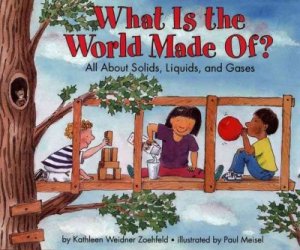Ideas: States of matter, reversible change – water to ice & vice versa (reversible change)
Materials: popsicles, labels, crayons, cups or bowls, spoons
As children come in, they choose a popsicle, unwrap it and put in a cup, write their name on the cup and leave the cup on a table in the window, then come back to the center for stories and songs.
Opening song: “Energy” from Nancy Stewart’s Sing a Song of Science
Book: What is the World Made Of? All About Solids, Liquids and Gases by Kathleen Weidner Zoehfeld (selections) and/or Freezing and Melting by Robin Nelson -we passed an ice cube around and talked about how it felt holding it (cold!!) and how our hands felt after we passed it to the next person (wet — why? because it melted a little).
Talk about solids, liquids, gases & have children demonstrate each (being perfectly still, moving a little—waving arms, slowly, then excitedly for gas)
Video/Song: “Solid, Liquid, Gas” by They Might be Giants from Here Comes Science 
Book: Why Did My Ice Pop Melt? By Susan Korman
Talk about liquid vs. solid
— what else melts? (chocolate . . .)
–how can you make things melt? (warm it up, put it in the sun); some things melt, others burn (reversible change vs. not reversible: paper, wood burn)
Pass around ice cube!
Song: “Rock & Roll Freeze Dance” from Hap Palmer’s So Big: Activity Songs for Little Ones
Take a bite ( or a drink) of popsicle – has it melted??
How could you make it melt faster??
Suggestions included warming it up with a hairdryer and putting it in the microwave.
 Book: Should I Share my Ice Cream? by Mo Willems
Book: Should I Share my Ice Cream? by Mo Willems
Song: “Ice Cream” by Asheba from Putumayo’s Picnic Playground:
Musical Treats from Around the World
–Free dance with scarves
After all this waiting, it’s time to eat popsicle soup!!
For more ideas, see Even More Picture-Perfect Science Lessons: Using Children’s Books to Guide Inquiry K-5 by Karen Ansberry (National Science Teacher’s Association), Chapter 6: Freezing and Melting.